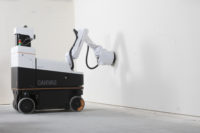Construction Robots Boost Quality, Earning Workers’ Approval
Advanced collaborative robotics and AI boost productivity, ensure consistent quality and enhance ergonomics in the drywall finishing process.
.jpg?1727183794)
Images courtesy of Canvas.
The manufacturing and logistics sectors have seen widespread automation adoption while the construction sector has lagged. In part, this is because every construction site is a unique and highly dynamic environment, and traditional robots thrive in the more predictable and fixed conditions.
Drywall Finishing Robots
Drywall finishing robots combine advanced LIDAR and 3-D sensing, advanced collaborative robotics and AI. The robots can automatically detect the wall surface and features, enabling them to be brought on-site and put to work immediately—no prior plans or time-consuming mapping required.
Using their sensing capabilities and robotic articulation, drywall finishing robots can spray and sand material with precision. This means that extremely high levels of quality, including Level 4 and 5 standards, can be achieved consistently.
In the hands of customers’ certified finishers, drywall robots can apply a defined profile onto the wall in one shot on the first day, let that dry for one drying cycle and sand it back on the second day. This greatly improves efficiency and reduces completion time by around 60 percent, to just two days–a major cost- and time-saving boon for project managers.
The key to drywall finishing robots’ versatility is the collaborative robot arm. It’s lightweight with advanced force control, which aids with precise sanding applications. It’s also easy to move around on a mobile platform, easy to use and, because it’s collaborative, safe to operate around people following a standard risk assessment.

Productivity Blues
The construction sector needs to double output over the next 40 years to meet expected demand. To put that into context, it’s the equivalent of adding an entire New York City to the world every month for 40 years. Unfortunately, the construction sector is in the midst of a severe labor shortage, with two people retiring from construction for every one that enters the sector.
Add to that a demanding and complex regulatory and safety environment, and it all results in a sector calling out for new solutions to make its workforce more productive and improve ergonomics.
Demanding Drywall
Exterior construction jobs typically involve heavy machinery, such as backhoes, excavators and tower cranes. However, if you look at the interiors of spaces across trades, the technology used is still almost entirely limited to hand tools.
A case in point is drywall finishing, one of the most labor-intensive jobs in construction, primarily because so many steps are required to get the job done. Typically, it takes between five and seven days of iterative joint compound application to finish a wall and get it ready to paint. In effect, drywalling 20,000 square feet of wall space takes about 100,000 square feet of work.
On some projects, largely because of the typical time scales involved, the drywalling component can be a loss leader or, at best, a “break even.” This is what my partner and I set out to solve, which resulted in the development of a worker-operated, robotic drywall finishing solution.

Why Workers and Unions Approve Drywall Finishing Robots
The new technology also provides relief to workers by taking on the most physically demanding elements of drywall jobs. One in four construction workers ends their career with a musculoskeletal problem, usually either a back injury or a rotator cuff injury, from holding their arms over their head and performing finishing and sanding work for their entire career.
Training on drywall finishing robots takes a week and, once successfully completed, seasoned and apprentice finishers can operate it independently. As a result, the worker can focus on higher-value tasks, from operating the robot (or several robots) to working alongside it on other jobs.
Uniquely, the new technology was developed and tested in close collaboration with unions. It turns out that all stakeholders care about workers having the best, safest and most productive work environment. The new tool improves working conditions while providing workers with new skills and upward mobility.
There are 75 independent trades in the construction sector, and many suffer from the same challenges, from labor shortages to non-ergonomic working conditions.
Many companies that make drywall finishing robots are currently focused on assisting workers with drywall projects, but engineers are working on enabling them to perform a wide range of interior construction duties, including painting. In the next decade, collaborative robot systems will become more common on construction sites—a massive transformation from the days when such locations were considered too complex for robots to handle.
Looking for a reprint of this article?
From high-res PDFs to custom plaques, order your copy today!






